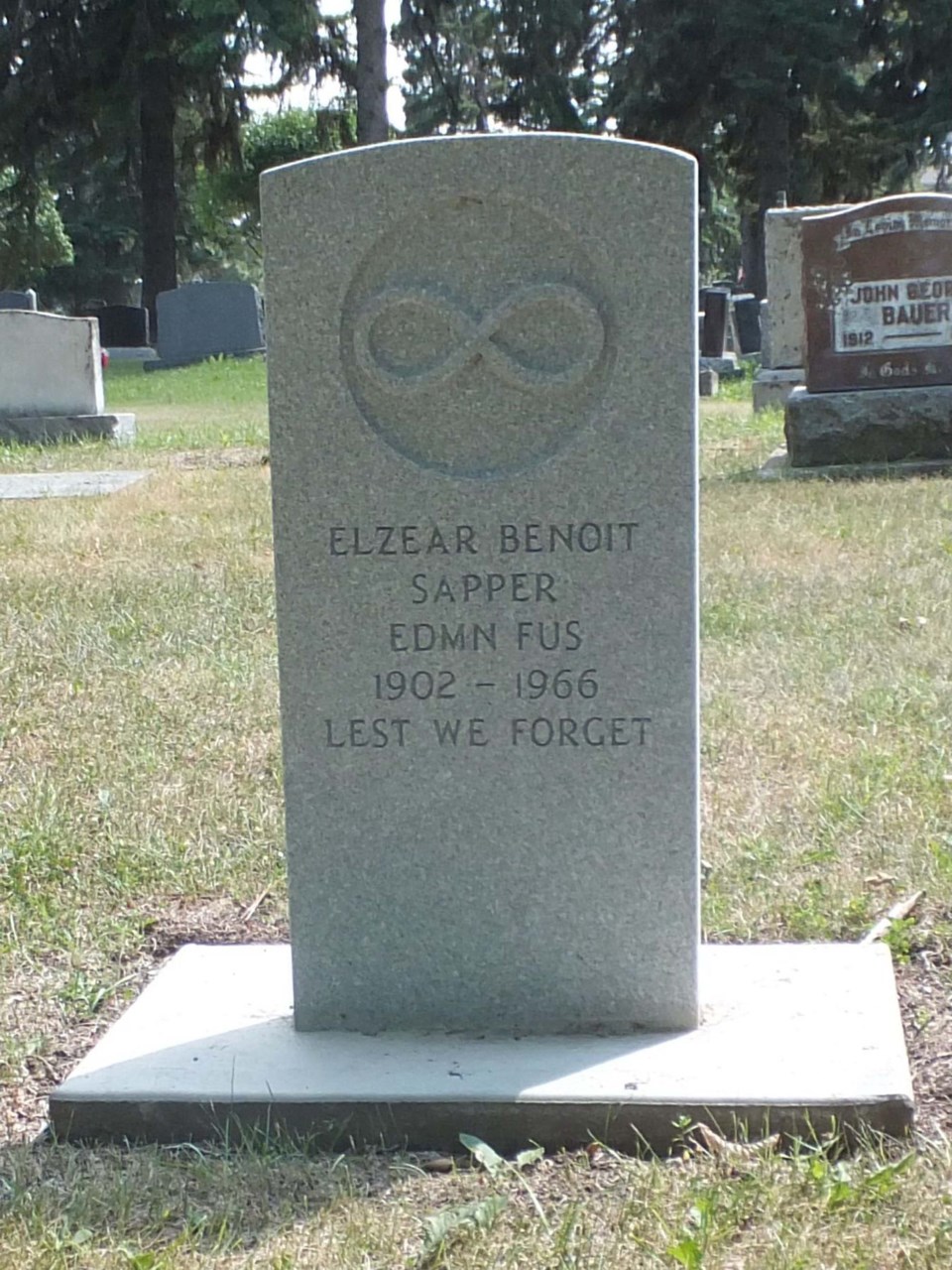After Elzear Benoit passed away in 1966, the Second World War veteran was buried in the St. Albert Roman Catholic Cemetery. For 55 years, his final resting place never had a marker. That was fixed only this summer after The Last Post intervened.
Benoit, a Métis veteran, now has a gravestone thanks to the efforts of Alison Glass and the Last Post Fund.
All of this was a wonderful surprise to his niece Theresa Gagnon, who still lives in Mission but doesn't have much knowledge of her father's brother.
"I do know he's one of five [children] in the family, and he was the second oldest," she said, divulging all of the details of her uncle's life she does know.
"He never lived in St. Albert. I didn't really know him. I'm the youngest in my dad's family and my dad was the oldest, so I didn't get to know him very well. I know that he worked in McBride, B.C. at the station there but I don't know if he was a station agent or if he worked on the railroad or what his job was. I know the other thing is he retired and moved to Seba Beach before he passed away," she said, adding, "Unfortunately, he was gone by the time I was growing up. I just didn't know much about him."
He was married to Mary Dion Benoit but they had no children, she said. Elzear lived in Seba Beach at the end of his life, but he was buried in St. Albert because this was his family home. His grandfather, Joe Benoit, arrived in St. Albert in 1867 but died in the smallpox epidemic three years later.
"We're eight generations here. St. Albert's been home a long time for us."
Gagnon once had her son try to do an Internet search to learn more. That's when they discovered that Elzear belonged to the 101st Regiment known as the Edmonton Fusiliers, which served in Canada in a home defence role during the Second World War.
"It was like a 'safekeeping' troop to keep the country here safe. They didn't go to war."
Sadly, many deceased veterans still have unmarked graves, primarily due to the financial burden of a headstone on families.
Calling herself a "cemetery nut," Glass is a local volunteer with Find a Grave, an organization that helps people find the final resting places of their ancestors. She was asked to determine where Elzear Benoit was buried. She started her quest with the records of the Alberta Genealogical Society.
"After a bit of searching and a phone call to my old next door neighbour — whose maiden name was Benoit — I determined he was in the St. Albert Roman Catholic Cemetery, but had no marker," she wrote to The Gazette.
She put in place the request to the Last Post Fund to establish a stone. Mandated under the Veterans Affairs Canada Funeral and Burial Program, it's a national non-profit organization with a mission to make sure every veteran receives a dignified funeral, burial, and military gravestone through its Unmarked Grave Program. In March 2019, the organization launched its Indigenous Veterans Initiative to commemorate and honour the memory of more than 18,000 Indigenous veterans, many of whom are believed to have unmarked graves.
The Last Post Fund also owns and manages its own military cemetery, known as the Last Post Fund National Field of Honour. It's located in Montréal.
Here in St. Albert, Elzear's headstone was installed a few months ago, much to Gagnon's excitement, Glass revealed. Bearing the Métis infinity symbol, the marker reads, "ELZEAR BENOIT, SAPPER, EDM FUS, 1902 - 1966, LEST WE FORGET." A sapper is a combat engineer, one that might build bridges or clear mine fields. Glass made sure to contact the Métis Nation of Alberta and the Canadian Aboriginal Veterans Serving Members Association so they could pay their respects as well.
Benoit's grave, Gagnon added, is perhaps seven metres away from that of her own father, Patrick.
No other public details of Elzear Benoit's service exist, not even his service number. Library and Archives Canada holds the country's collection of records of all who served in the military and in the early years of the North West Mounted Police. The records include muster rolls, military service files, unit war diaries, medal registers, photographic collections, documentary art and posters, as well as published sources, according to the Military Heritage homepage. On its search page, it stipulates that there are no access restrictions on the service files for Canadian Armed Forces members who died in service between 1939 and 1947, including those killed in action, those who subsequently died of injuries related to service, and those who died because of accident or illness while in service.
Until now, the only place you would have seen Elzear Benoit's name recorded in affiliation with his military service was among the many hundreds of names on the National Métis Veterans' Memorial Monument at Batoche in Saskatchewan. You can read his name there on the outside of column 8, row 69.




